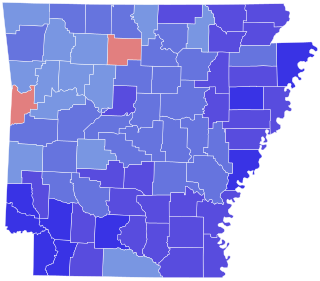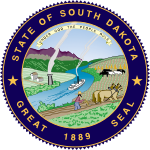
The 1974 United States Senate election in South Dakota was held on November 5, 1974. Incumbent Democratic U.S. Senator George McGovern, who had lost the 1972 United States presidential election to Richard Nixon ran for reelection to a third term and won, despite having also lost his home state two years prior.

The 1976 New Hampshire gubernatorial election was held on November 2, 1976. Incumbent Republican Governor Meldrim Thomson Jr. defeated Democratic nominee Harry V. Spanos with 57.66% of the vote.

The 1974 New Hampshire gubernatorial election was held on November 5, 1974. Incumbent Republican Governor Meldrim Thomson Jr. defeated Democratic nominee Richard W. Leonard with 51.15% of the vote.

The 1974 Arkansas gubernatorial election was held on November 5, 1974.

The 1970 South Dakota gubernatorial election was held on November 3, 1970. Primary elections were held on June 2, 1970. Incumbent Republican Governor Frank Farrar was defeated by Democratic nominee Richard F. Kneip who won 54.85% of the vote.

The 1968 South Dakota gubernatorial election was held on November 5, 1968.

The 1966 South Dakota gubernatorial election was held on November 8, 1966.

The 1964 South Dakota gubernatorial election was held on November 3, 1964.

The 1962 South Dakota gubernatorial election was held on November 6, 1962.

The 1958 South Dakota gubernatorial election was held on November 4, 1958.

The 1956 South Dakota gubernatorial election was held on November 6, 1956.

The 1954 South Dakota gubernatorial election was held on November 2, 1954.

The 1960 Arkansas gubernatorial election was held on November 8, 1960.

The 1964 Delaware gubernatorial election was held on November 3, 1964.

The 1960 Delaware gubernatorial election was held on November 8, 1960.

The 1950 Texas gubernatorial election was held on November 7, 1950.

The 1952 South Dakota gubernatorial election was held on November 4, 1952.

The 1946 South Dakota gubernatorial election was held on November 5, 1946. Incumbent Republican Governor Merrell Q. Sharpe ran for re-election to a third term, but was defeated in the Republican primary by Attorney General George T. Mickelson. In the general election, Mickelson faced farmer Richard Haeder, the Democratic nominee. In part because of South Dakota's growing trend toward the Republican Party, and because of the national Republican landslide, Mickelson easily defeated Haeder, winning 67% of the vote to Haeder's 33%.

The 1914 South Dakota gubernatorial election was held on November 3, 1914. Despite a close election in 1912, incumbent Republican governor Frank M. Byrne defeated Democratic nominee James W. McCarter, an Edmunds County Judge, with 50.07% of the vote. Coincidently, Bryne's Democratic opponent in 1912, Edwin S. Johnson, was elected the same year to represent South Dakota in the United States Senate.

The 1918 South Dakota gubernatorial election was held on November 5, 1918. Incumbent Republican Governor Peter Norbeck ran for re-election to a second term. He won the Republican primary unopposed and faced Nonpartisan League candidate Mark P. Bates, a farmer, and Democratic nominee James E. Bird in the general election. Norbeck's share of the vote decreased from 1916 to 53%, but he benefited from the split field. Bates placed second with 26% of the vote, while Bird placed third with 19% of the vote.






















